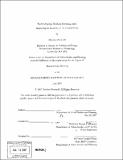| dc.contributor.advisor | Dennis Frenchman. | en_US |
| dc.contributor.author | Brownell, Matthew (Matthew Christopher) | en_US |
| dc.contributor.other | Massachusetts Institute of Technology. Dept. of Urban Studies and Planning. | en_US |
| dc.date.accessioned | 2008-01-10T16:02:46Z | |
| dc.date.available | 2008-01-10T16:02:46Z | |
| dc.date.copyright | 2007 | en_US |
| dc.date.issued | 2007 | en_US |
| dc.identifier.uri | http://hdl.handle.net/1721.1/39928 | |
| dc.description | Thesis (M.C.P.)--Massachusetts Institute of Technology, Dept. of Urban Studies and Planning, 2007. | en_US |
| dc.description | Includes bibliographical references. | en_US |
| dc.description.abstract | Le Corbusier's "towers in the park" urban design plan had a profound impact on city form in the United States. Its precepts were used to inform many urban renewal schemes of the 1950s and 1960s that tore down existing urban fabric and replaced it with towers surrounded by undefined open space. Streets were closed off and rerouted to create "superblocks" for these Corbusian tower/park plans but very soon after urban renewal began, people started to decry its effects. Besides the loss of neighborhoods and harm to people forced to move, the new plans often suffered from safety concerns and isolation. The ground planes of Corbusier inspired plans were disconnected from the public. Over time advocates of traditional city form have pushed new ideas to the forefront of urban design to facilitate a pedestrian-friendly environment, such as new urbanism and smart growth. This paper examines the impact of Corbusier's urban designs versus traditional city movements and suggests a middle ground. Towers are not inherently bad and a form-based approach to city design, such as the one used in Vancouver, successfully integrates both towers and pedestrian-scaled environments. Towers and traditional city form can coexist and benefit from each other to address urban design problems shared by both Corbusier and today's planner. | en_US |
| dc.description.statementofresponsibility | by Matthew Brownell. | en_US |
| dc.format.extent | 135 p. | en_US |
| dc.language.iso | eng | en_US |
| dc.publisher | Massachusetts Institute of Technology | en_US |
| dc.rights | M.I.T. theses are protected by copyright. They may be viewed from this source for any purpose, but reproduction or distribution in any format is prohibited without written permission. See provided URL for inquiries about permission. | en_US |
| dc.rights.uri | http://dspace.mit.edu/handle/1721.1/7582 | |
| dc.subject | Urban Studies and Planning. | en_US |
| dc.title | Redeveloping modern housing sites : improving the livability of the ground plane | en_US |
| dc.type | Thesis | en_US |
| dc.description.degree | M.C.P. | en_US |
| dc.contributor.department | Massachusetts Institute of Technology. Department of Urban Studies and Planning | |
| dc.identifier.oclc | 182759246 | en_US |
